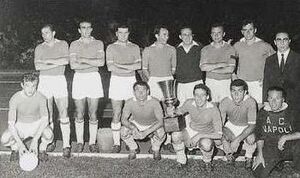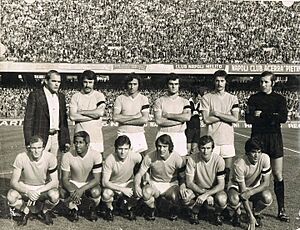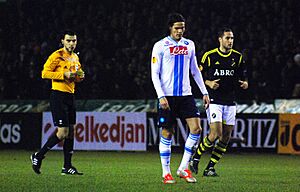History of SSC Napoli facts for kids
Società Sportiva Calcio Napoli, often called Napoli, is a famous football club from Southern Italy. It is one of the biggest clubs in the Italian Serie A league. Napoli's long history began in 1905 as Naples Foot-Ball Club.
The club has been restarted a few times, most recently in 2004. Napoli has spent most of its history playing in Italy's top league, Serie A. The team is most famous for the time when Diego Maradona played for them, from the 1980s to the early 1990s. During this period, Napoli won several important trophies, including the scudetto (the Italian league title) and the Coppa Italia twice. They also won a European trophy, the UEFA Cup.
Contents
How Napoli Started: From Naples to Internaples
Football first came to Naples in the early 1900s, brought by English sailors. The first two clubs, Football Club Partenopeo and Naples Foot-Ball & Cricket Club, both started in 1905.
Naples FCC was founded by William Poths, an Englishman who loved football. He held a meeting in Naples to create the club. Poths, along with another Englishman, Mr. Bayon, and three Neapolitans (Conforti, Catterina, and Amedeo Salsi), formed Naples FCC. Amedeo Salsi became the club's first president.
|
|
| Original Naples kit |
Their first uniform had a sky blue and navy blue striped shirt with black shorts. Naples played their first match against British sailors from a ship called Arabik. They played for a trophy named "Coppa Salsi" after their first president. Naples won the game 3–2, which was impressive because Arabik had beaten the strong Genoa team just days before.
A year later, the "Cricket" part was removed from the club's name, making it simply Naples Foot-Ball Club. In 1909, Sir Thomas Lipton, famous for Lipton tea, started a competition called the Lipton Challenge Cup. In this cup, teams from Naples and Sicily played against each other every year. Naples often played against Palermo Foot-Ball Club in the finals. Naples won the first competition 4–2 and also won it in 1911 and 1914.
|
|
| Original Internazionale Napoli kit |
In 1912, some foreign players left Naples FBC and formed a new club called US Internazionale Napoli. This created a rivalry between the two Naples clubs. They played against each other in the Italian Championship. In 1922, because of money problems, the two rival clubs joined together. They became the Foot-Ball Club Internazionale-Naples, or FBC Internaples.
The Birth of Associazione Calcio Napoli
On August 25, 1926, the members of Internaples decided to change the club's name. Giorgio Ascarelli became the first president of Associazione Calcio Napoli. In their first season in the top league, Napoli finished last in their group, earning only 1 point from 18 games.
This poor start earned them the nickname I ciucciarelli, meaning "the little donkeys". Before this, the club's symbol was a horse, like the city of Naples. But after that season, some people joked that they were like donkeys. However, the club proudly adopted O Ciuccio (the donkey) as their mascot. In the next two seasons, they slowly improved.
Before World War II, a great hero for Napoli fans was Attila Sallustro. His family moved to Naples from Paraguay when he was a child. Sallustro came from a wealthy family and did not take a salary from the club. Instead, he received a fancy car. He was a fantastic goal scorer, scoring 22 goals in 28 games in the 1928–29 season.
Napoli in the 1930s: Joining Serie A
In the 1930s, Italian football changed to the league format we see today. In the 1929–30 season, Napoli showed what they could do, finishing fifth. They beat strong teams like Torino, Lazio, and Milan. Around this time, Sallustro and Marcello Mihalic became the first Napoli players to be called up to the Italy national team.
For the next six seasons, Napoli consistently finished in the top ten. They even finished third twice, in 1932–33 and 1933–34, under the famous English coach William Garbutt. Another important player from this time was Antonio Vojak. He joined from Juventus in 1929 and scored 102 goals in 190 games for Napoli over six years. Guillermo Stábile, the top scorer of the 1930 FIFA World Cup from Argentina, also played for Napoli in the 1935–36 season.
Napoli's performance went up and down in the years before World War II. They almost dropped to a lower league in 1937 and again in 1940. In 1942, Napoli finally went down to Serie B. In 1943, they almost got promoted back to Serie A but finished third, just two points short. After that season, they moved from their Stadio Giorgio Ascarelli stadium to the Campo Vomero.
Napoli After the War
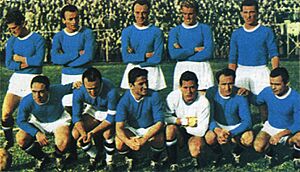
After World War II, the championship was played regionally in 1946. Napoli proved to be the best team in the Centro-Sud region, losing only three matches. They finished tied on points with Bari but had a better goal average. This was enough to secure their spot in Serie A the next year.
Napoli stayed in Serie A for only one season before being relegated again in 1948. However, they became champions of Serie B in 1949–50, earning promotion back to Serie A. For the next five seasons, they played well, finishing in the top six. In 1956, a Napoli match was one of the first Serie A games ever shown on RAI television. For the rest of the 1950s, their league results varied, including a strong fourth-place finish in 1957–58.
The 1960s were a mixed time for Napoli. They were relegated in 1961 but quickly returned to Serie A by finishing second in Serie B the next season. The year 1962 was also special because Napoli won the Coppa Italia. They beat SPAL 2–1 in the final, becoming the first club from Serie B to win the competition. Unfortunately, Napoli was relegated again soon after this cup success.
Società Sportiva Calcio Napoli: Rising Again
In the mid-1960s, the club started to improve. Their name was changed to Società Sportiva Calcio Napoli on June 25, 1964. They were promoted from Serie B as runners-up in the 1964–65 season. In their first season back in Serie A, the team finished an impressive third place with Argentine manager Bruno Pesaola leading them. They also won the Coppa delle Alpi trophy that year, beating Juventus.
Napoli came very close to winning the league in 1967–68, finishing second behind Milan. During this period, Napoli had many famous players, including future 1982 World Cup winner Dino Zoff, top scorer José Altafini, and Naples-born defender Antonio Juliano. The club remained among Italy's top teams in the early 1970s, finishing third twice.
The 1974–75 season, under coach and former Napoli player Luís Vinício, was the closest Napoli had ever been to winning the scudetto. They finished just two points behind champions Juventus. Although they didn't win the league, their strong performance earned them a spot in the 1974–75 UEFA Cup, where they reached the third round.
Napoli won their second Coppa Italia trophy that same season. They beat Hellas Verona 4–0 in the final. They also won the Anglo-Italian League Cup, beating English side Southampton 4–1 over two games.
Because they won the Coppa Italia, Napoli played in the 1976–77 European Cup Winners' Cup. They reached the semi-finals of this European competition. In the last two seasons of the 1970s, Napoli finished sixth in the league.
The Maradona Years: League and European Triumphs
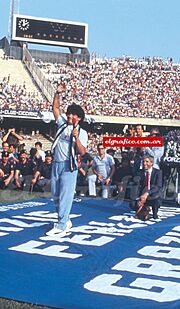
The 1980s started well for Napoli, with third and fourth-place finishes. But it was when Argentine superstar Diego Maradona joined the club from Barcelona in 1984 that Napoli became famous worldwide.
Success with Maradona didn't happen right away. The team worked hard, finishing eighth in 1984–85 and then third in 1985–86. The 1986–87 season was Napoli's year with Maradona. Napoli won the scudetto for the first time ever! They also became the first and only team from mainland Southern Italy to win the league, a record that still stands. That season, they also won the Coppa Italia, beating Atalanta 4–0 in the final to complete the double (winning both the league and cup).
The next year, Napoli was knocked out of the European Cup by Real Madrid. However, finishing second in Serie A meant they qualified for the UEFA Cup. Napoli beat strong teams like Juventus and Bayern Munich on their way to the final. In the final, Maradona and Careca scored goals to beat VfB Stuttgart 2–1 in the first game. The second game in Stuttgart ended in a 3–3 draw, giving Napoli their first European trophy. Napoli also reached the Coppa Italia final that year but lost to Sampdoria.
In 1990, Napoli won the league again. During the 1990 FIFA World Cup in Italy, Maradona famously asked Neapolitans to support his Argentina national team over the Italian team. Napoli fans showed a banner that read, "Maradona, Naples loves you, but Italy is our homeland." Napoli was the only stadium where the Argentine anthem was not booed. Maradona left less than a year later, as the club faced money problems.
The following year, Napoli won the Supercoppa Italiana, beating Juventus 5–1. This was Napoli's last major trophy for 22 years. The 5–1 win was a record victory margin in the competition, a record that still stands today.
A Period of Decline
After winning the Supercoppa Italiana, the club slowly declined. Key players like Gianfranco Zola, Daniel Fonseca, and Careca left. In the early 1990s, the club still did reasonably well in the league, but not as high as during the Maradona era. After finishing fourth in 1991–92, their league form got worse.
In 1997, Napoli reached the Coppa Italia final but lost to Vicenza. By this time, their league performance was much weaker. In 1998, they were relegated to Serie B, winning only two games all season.
Many players were sold in the summer of 1997. Napoli had to wait until the 1999–2000 season to get promoted back to Serie A. However, in their season back in Serie A, Napoli was immediately relegated again.
In 2001–02, Napoli failed to get promoted, missing out by one spot in the Serie B table. This started a downward trend for the club. In the next season, they finished a low 16th. Even worse, the club faced huge money problems. In August 2004, the club was unable to pay its debts.
A New Beginning Under De Laurentiis
A new club was formed under the name Napoli Soccer, thanks to film producer Aurelio De Laurentiis. His goal was to make sure Naples still had a football team. In their first season in Serie C1 (a lower league), Napoli almost got promoted but lost in the play-offs.
In the 2005–06 season, Napoli did even better and won the Serie C1 championship. They secured promotion on April 15, 2006, with a 2–0 win at the Stadio San Paolo. Even though Napoli was in a lower division, they still had one of the largest fan bases in Italy. They had more fans attending games than most Serie A clubs, even breaking the Serie C attendance record with 51,000 fans at one game. In May 2006, the club's name was changed back to S.S.C. Napoli by chairman De Laurentiis.
Returning to Serie A
The team became one of the top clubs in Serie B. For much of the season, Napoli was in second place, fighting for direct promotion to Serie A alongside Genoa. On June 10, 2007, Napoli earned direct promotion to Serie A. Their match ended in a 0–0 draw, and other results meant both Napoli and Genoa were promoted. The 2007–08 season was Napoli's first time back in Serie A since 2001, and the first time under the new club after its financial difficulties.
Manager Edoardo Reja was replaced by former Italy national team manager Roberto Donadoni in March 2009. Donadoni was then replaced by Walter Mazzarri in October. Under Mazzarri, Napoli moved up the league table, finishing sixth and qualifying for the 2010–11 UEFA Europa League. With Mazzarri and new players like Edinson Cavani, Napoli spent part of the 2010–11 season in second place, eventually finishing third. This earned them a direct spot in the group stage of the 2011–12 UEFA Champions League.
In the 2011–12 season, Napoli finished fifth in Serie A. However, they beat unbeaten champions Juventus in the Stadio Olimpico to win the Coppa Italia for the fourth time, 25 years after their last cup win. Cavani and Marek Hamšík scored the goals. Napoli also had a good season in the 2011–12 UEFA Champions League, their first time in Europe's top tournament since 1990–91. They finished second in their group, ahead of Manchester City, and reached the round of 16, where they were knocked out by eventual winners Chelsea. In 2012–13, Napoli finished second in Serie A, their best performance since winning the league in 1989–90. Cavani was the top scorer with 29 goals. He was then sold to Paris Saint-Germain for a club record fee of £57 million.
In 2013, Walter Mazzarri left Napoli and was replaced by Spanish coach Rafael Benítez. Benítez was the club's first foreign coach since 2000. The money from selling Cavani was used to sign three Real Madrid players – Gonzalo Higuaín, Raúl Albiol, and José Callejón – along with other players like Dries Mertens and Pepe Reina. Napoli finished the season by winning the 2014 Coppa Italia Final, their fifth Coppa Italia title, with a 3–1 win against Fiorentina. They also qualified for the Champions League by finishing third in Serie A. Benítez left for Real Madrid in May 2015 and was replaced by Maurizio Sarri.
In the 2017–18 season, Napoli fought for the league title all season and finished with a club record of 91 points. However, Juventus won the title in the second-to-last round. On December 23, 2017, Marek Hamšík became Napoli's all-time leading scorer, passing Diego Maradona, with his 115th goal. At the end of the season, Sarri left for Chelsea, and Carlo Ancelotti became the new coach in May 2018. He led the club to another second-place finish. Ancelotti was replaced by Gennaro Gattuso in December 2019. On June 14, 2020, Dries Mertens became Napoli's all-time top scorer, scoring his 122nd goal. Napoli went on to win the 2019–20 Coppa Italia in a penalty shoot-out against Juventus in the final.
In December 2020, Napoli renamed their stadium San Paolo after Diego Maradona, following the death of their beloved club legend. Napoli finished fifth in Serie A that season, missing a Champions League spot by one point.
In the 2021–22 season, Luciano Spalletti became the new head coach. He led the team to third place in Serie A, securing a Champions League spot after two years.
In the 2022–23 season, Napoli won the Serie A title for the first time since the 1989–90 season, and their third title overall. They clinched the title on May 4, 2023, after a 1–1 draw against Udinese. This was their first league title since the days of Diego Maradona. In the Champions League, Spalletti led them to the quarter-finals for the first time in their European history. They were beaten 2–1 by fellow Serie A side Milan.
Images for kids
-
Kock – Goalkeeper
-
Garozzo – Defender
-
Del Pezzo – Defender
-
Littie – Defender
-
Steinecaer – Defender
-
Marin – Midfielder
-
Scarfoglio – Midfielder
-
McPherson – Midfielder
-
Chaudorir – Midfielder
-
Poths – Forward
-
Ostermann – Forward
See also
 In Spanish: Historia de la Società Sportiva Calcio Napoli para niños
In Spanish: Historia de la Società Sportiva Calcio Napoli para niños


